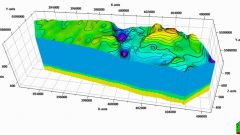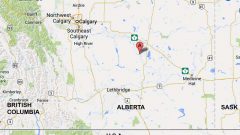Experts from the Alberta Geological Survey, and University of Alberta have found the site of what is undoubtedly a huge meteor strike.
The crater, at least 50 million years old, has long since been worn away and filled in, but evidence shows it was huge, at eight kilometres across.
Doug Schmitt (PhD) professor of Geophysics and Canada Research Chair of Rock Physics at the University of Alberta.
ListenThe explosion from the meteor that smashed into the earth those millions of years ago, would have wiped out anything within 200 kilometers.

3D imaging showing the depression around the exterior ring and the central peak. Over millions of years the vast wall of material around the impact, the deep hole and high central peak have all eroded to the point of being virtually unnoticeable on the landscape now. (CLICK to ENLARGE)
Professor Schmitt suggests that depending on the actual composition of the meteor and travelling at the incredible speed of 30 kilometres/second, it would have been probably up to half a kilometer in diameter if comprised of iron, and a kilometer in diameter if made of rock.
Schmitt says the crater would have been about 1.5 km deep with a high central peak and outer debris field almost that high, all of which has since eroded to leave no visible trace on the surface

The formation was originally discovered during what would have been a routine subsurface topography survey. The layers under the surface in the area should have been fairly flat and even, but geologist Paul Glombeck noticed that there some strange anomalies.
Professor Schmitt and his team were called in to further analyze the data and determined that all the evidence pointed to a huge and ancient impact crater.

Red dot indicates Bow City, Alberta and the site of impact crater. The force was such that the blast would have wiped out any living creature with 200 km. (google ) CLICK to ENLARGE
He says the fact that this impact was unknown until now, is evidence that there are probably many other still undiscovered meteor impacts, which he says have helped develop the earth’s structure, geological and geographical features.
He also says the earth is being hit by many meteors, mostly small, but we never see them as most of the earth is covered by ocean and they hit the sea out of our sight or notice.
A scientific paper on the analysis was publised in the journal Meteoritics and Planetary Science- abstract here
Meanwhile, a large and potentially disastrous asteroid the size of a double-decker bus sped past the Earth over the weekend. The boulder flew within 186,000 miles of the planet after being spotted by astronomers a few days before. That may seem far away but the asteroid in fact passed well within the moon’s orbit of the earth which is about 238,855 miles away.







For reasons beyond our control, and for an undetermined period of time, our comment section is now closed. However, our social networks remain open to your contributions.